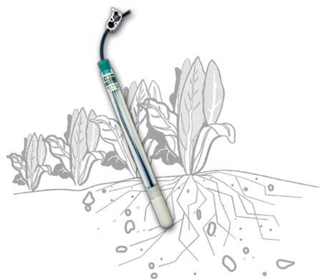SSAT 24" Soil Solution Access Tube
SSAT (Soil Solution Access Tubes), or Suction Lysimeters, were developed to easily extract soil water samples for testing. They provide the user with an accurate method of determining salinity or plant nutrient levels. Because the sample is collected at root zone depth, it reflects the true impact fertilization has on the plant material. Understanding soil water conditions helps the user make informed fertigation scheduling decisions resulting in improved yield and reduced fertilizer, water, lbaor and energy costs.
Includes:
- Tube
- Suction line
- Stopper
- Line clamp
Features:
- Easy to install and use
- Standard ceramic tip (white) for most soil types
- Low Tension tip (blue) for sandy soils and growing media
- Collects soil water sample at the root zone
Operating Principle
The SSAT shares a few construction features with the very popular IRROMETER instrument which measures soil water tension. The SSAT consists of a sealed plastic tube that is equipped with a porous ceramic tip on the bottom end. The tube is installed in the ground with the ceramic tip placed at desired root zone depths. After an irrigation / fertigation event, a slight vacuum is applied to the tube which has a suction line extending past the top seal and a clamp to seal it off. The vacuum in the tube draws soil water through the porous ceramic tip where it accumulates in the tube. To collect the sample from the tube the operator simply connects a syringe to the suction line, un-clamps the tubing and draws it out or, using the double suction line option, pressurizes the tube to push the sample out. The sample can then be analyzed in the field or at the laboratory. This soil nutrient information helps the user make informed fertilization decisions.
Applications
Crop consultants, irrigation professionals and researchers find the SSAT particularly useful because of its ability to easily gather soil water samples for testing. Commercial growers see the value of soil water sampling at the root zone because it reflects the net “effect” that fertilization has as it interacts with previously applied nutrients in the soil. Scientists also use this equipment when identifying and researching environmental contaminants and their movement in soil.
Specification Information
The operator shall incorporate soil water sampling equipment to aid in making fertilization scheduling decisions. The soil solution access tubes shall collect samples at the root zone for analysis in the field or laboratory. Tube shall be constructed of durable plastic that is impervious to attack by soil chemicals, with a ceramic tip. All ceramic to plastic connections shall be guaranteed leak proof. The soil sampling device shall be a Model SSAT as manufactured by the IRROMETER Company, Inc. of Riverside, California.
SSAT - Helps you determine when and how much fertilizer to apply.
Soil Solution Access Tubes are typically used to extract soil water samples from varying depths in the root zone of crops. When used in conjunction with tissue analysis for calibration, management practices can be developed which allow the grower to adjust the rate and timing of fertilizer applications. The user benefits from increased production and higher quality, while minimizing fertilizer expense and mitigating the leaching of nutrients. SSATs are frequently used for measuring nitrate levels, salinity, EC or other chemical elements commonly associated with soil water management in irrigation (fertigation) regimens.
 | They allow the user to take full advantage of residual and mineralized nitrogen by delaying or minimizing fertilizer applications. Monitoring below the root zone can verify the presence or absence of nitrate leaching. Tubes longer than the necessary sampling depth are routinely used to allow for sufficient vacuum capacity and/or larger sample size. For example, using an 18 in. SSAT for sampling at a 6 in. depth allows the tube to remain under a sufficient vacuum for a longer period of time. We recommend using the #1002- SSAT Hand Vacuum Pump on tubes longer than 12 in. (30 cm) to apply proper vacuum. SSAT tubes longer than 3 ft. (90 cm) benefit from the use of a second suction line which offers multiple methods of extracting soil water samples. The extracted soil water samples are commonly tested with electronic meters or portable test kits. This useful in-field sampling technique is quick and easy to perform, which makes it well suited to the frequent fertigation schedules common with certain growing conditions. |